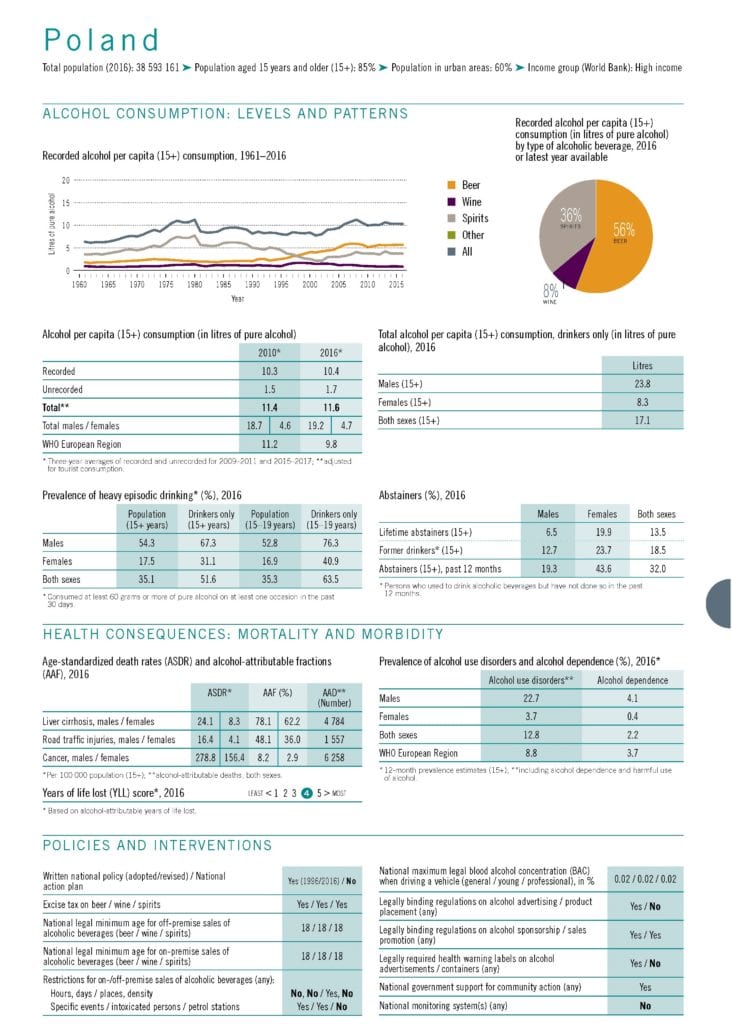Movendi International reported previously that 2019 saw the highest alcohol consumption in Poland in the last three decades. According to the State Agency for the Prevention of Alcohol-Related Problems (PARPA), alcohol consumption increased by 0.23 liters per capita in 2019 compared to 2018. The increase brought the Polish alcohol consumption to 9.78 liters of pure alcohol per person, the highest it has been since 1993.
The popularity of little liquor bottles called “monkeys” has been contributing to rising alcohol use. They are small bottles of liquor, often colorful and flavored, and easily, widely and cheaply available. Reportedly, sales of these small bottles have not decreased even during the ongoing COVID-19 pandemic. It is estimated that 3 million people buy them in Poland on a daily basis and 600,000 purchase these bottles twice a day. Yearly, over 1 billion “monkeys” are sold.
Local action to reduce alcohol availability
In the face of rising alcohol use and related harm, Polish local governments have been working to improve alcohol policy solutions, for instance by reducing alcohol availability in their efforts to prevent and reduce massive harm. Local governments can reduce availability for example by reducing pools of permits for sale of alcohol. In 2019, there was a reduction 3500 permits in circulation compared to 2018.
As a result of lowering availability of alcohol the number of specialized alcohol stores in Poland has fallen to the lowest level in years. According to the Central Statistical Office, there was reduction of 900 specialized alcohol stores in 2019 compared to 2018.
The reductions are visible in other places where alcohol is sold as well. Comparing to 2018 in 2019, the number of general grocery stores offering alcohol reduced by 3100 and restaurants with a bar serving alcohol reduced by 650.
Overall there were 124,000 venues selling alcohol in Poland at the end of 2019 which is 4000 alcohol outlets less than in 2018.
Nevertheless, it could take a while for reduced alcohol availability to translate into changes in alcohol consumption. Other factors driving consumption, such as price and marketing, should therefore also be included in the efforts to protect communities from alcohol harm.
Need for more action
The reductions in alcohol availability in Poland are positive for public health and safety, but more needs to be done to reduce alcohol consumption and prevent harm in the country.
The rise in alcohol consumption coincides with the weakening of alcohol policy measures in Poland.”
Dr. Witold Zatonski, European Observatory of Health Inequalities at the State Higher Vocational School in Kalisz, President of the Health Promotion Foundation
Data from PWSZ shows that in Poland about 110,000 people were killed by alcohol in the last 15 years. Acording to experts the main reason is the rising alcohol consumption trend seen since 2003. Research by Dr. Witold Zatoński from the European Observatory of Health Inequalities at the State Higher Vocational School in Kalisz and President of the Health Promotion Foundation shows that the rise in alcohol consumption coincides with the weakening of alcohol policy measures in Poland. The rise began after 2000.
In 2001, beer advertising returned to television and in 2002 excise taxes on alcohol were slashed by 30%.
As WHO data from the 2018 Global Alcohol Status Report shows, Poland belongs to the countries in the world with a high score concerning years of life lost due to alcohol.
- More than 6000 cancer deaths are due to alcohol in Poland every year.
- More than 4,500 liver cirrhosis deaths are caused by alcohol, yearly.
- 22.7% of Polish men have an alcohol use disorder.
- 63.5% of Polish alcohol consuming youth between 15 and 19 years of age engage in binge alcohol use.
Increasing taxes and advertising bans are two of the alcohol policy best buys recommended by the World Health Organization (WHO) to tackle the Polish alcohol burden. The WHO has also launched the SAFER package as a blueprint for governments to use to implement the best buy measures for alcohol policy.

